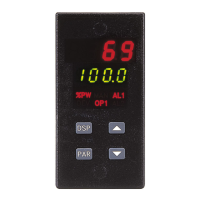OPERATION OVERVIEW
Controller Power-up
Uponapplying power,the controllerdelayscontrol actionand temperature
indication for five seconds to perform several self-diagnostic tests and
display basiccontroller information. Initially,the controller illuminates both
displays and all annunciators to verify that all display elements are
functioning. The controller then displays the programmed input sensor type
in the main display (verify that the input select sensor jumper matches the
programming). Concurrently, it displays the current revision number o f the
operating system software in the bottom display. The controller checks for
correct internaloperation anddisplays an errormessage (E-XX)if an internal
fault is detected (see Troubleshooting, page 78, for further information).
Upon completion of this sequence, the controller begins control action by
displaying the temperature and updating the outputs based upon the PID
control calculation.
Controller Power Down
At power down,the steady state control valueas well as all parametersand
control modes are saved, to provide a quick and predictable temperature
response on the next power-up.
When powering down the process, it is important to power down the
controller at the same time. This prevents the reset action of the controller
from shifting the proportional band while the temperature is dropping and
prevents excessive overshoot on the n ext process start-up.
Process Start-up
After starting the process, the controller’s PID settings must be initially
“tuned” to the process for optimum temperature control. Minimal tuning
consists of adjusting the Proportional Band, Integral Time, and Derivative
Time parameters to achieve the optimum response to a process disturbance.
The controllercan be tunedonce, but mustbe re-tunedif the processhasbeen
changed significantly. Several options exist for tuning these parameters:
A)Usethe controller’sbuilt-inAuto-Tunefeature (seeAuto-Tune,page68).
B) Use a manual tuning technique (see Manual Tuning, page 81).
C) Use a third party tuning software package (generally expensive and not
always precise).
D) Use v alues based on control loop experience, calculated values or values
from a similar process.
If the controller is a replacement, the PID settings from the unit being
replaced may be used as good initial values. Be sure to consider any
differencesin the unitsand thePID settingswhen replacing.The PIDsettings
maybefinetuned byusingthetechniques outlinedinthe PIDControlsection.
Aftertuning thecontroller tothe process,it isimportantto powerthe loadand
the controller at the same time for best start-up response.
Manual (User) & Automatic Operation
The controller canbe transferred between Automaticcontrol (closed loop;
PID or ON/OFF control) and Manual control (open loop). In the Hidden
Function Mode, the “trnf” parameter allows the operator to select thedesired
operating mode. To allow front panel switching between control modes,
program the transfer (trnf) parameter to “Enbl” in the Lockout Module. The
user input or RS485 serial interface option may also be used to perform the
auto/manual transfer function, independent of the setting in the Lockout
Module.
Manualoperationprovides directcontrolofthe output(s)from0to+100%,
or -100% to +100% if cooling output is installed. For Valve Positioner
models with slidewire feedback, this mode allows manual valve positioning.
TheMAN (REMforRemoteSetpoint models)annunciator flashestoindicate
that the unit is in manual operation. When transferring the controller mode
from/to automatic, the control power output(s) remain constant, exercising
true “bumpless” transfer. When transferring from manual to automatic, the
power initially remains steady but integral action corrects (if necessary) the
closed loop power demand at a rate proportional to the Integral Time. The
programmablehigh andlowpower limitvaluesareignored whenthe unitisin
manual operation.

